Accepted Scientific Name: Gerrardanthus macrorhizus Harv. ex Benth. & Hook.f.
Gen. Pl. [Bentham & Hooker f.] 1: 840 1867 Benth. & Hook.f.
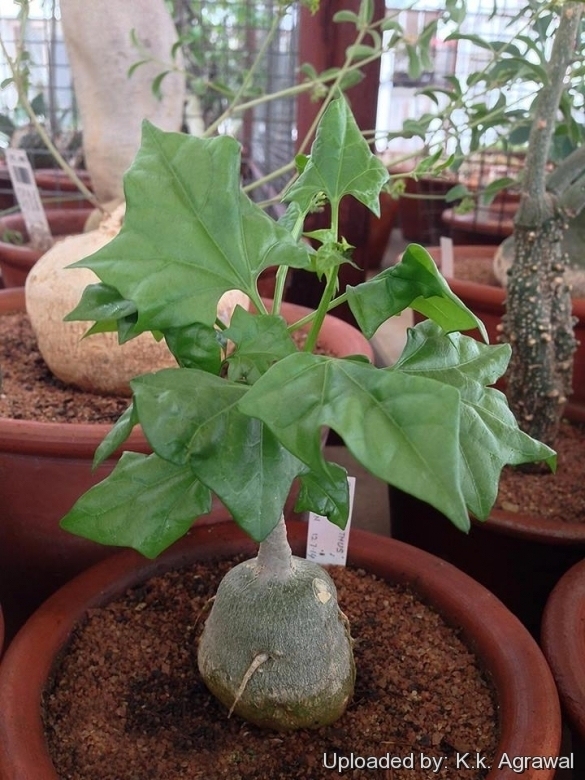
Gerrardanthus megarhiza (Gerrardanthus macrorhizus) Photo by: K.k. Agrawal
Origin and Habitat: Republics of South Africa (Eastern Cape, KwaZulu-Natal), Swaziland.
Altitude range: 5-650 metres above sea level.
Habitat and ecology: Lowland forests, hygrophilous bush and rocky ledges in wooded valley regions on the east coast.
Synonyms:
See all synonyms of Gerrardanthus macrorhizus
back
Accepted name in llifle Database:Gerrardanthus macrorhizus Harv. ex Benth. & Hook.f.Gen. Pl. [Bentham & Hooker f.] 1: 840 1867Synonymy: 3
back
Common Names include:
ENGLISH: Bigfoot
AFRIKAANS (Afrikaans): Rotspatat
Description: The Bigfoot, Gerrardanthus macrorrhizus, is a perennial climber, expanded at the base into a succulent pumpkin-like caudex, usually about 30-40 cm in diameter. The smooth, alternate leaves are ivy-shaped, shiny and prominently veined. The Bigfoot has small, dark brownish-yellow orchid-like flowers. There are male and female plants. If a female flowers is fecundated, it is followed by pendulous fruit, which resembles a sea cucumber, and opens at the lower tip to release a number of large, papery, winged seeds. Unlike its close relative Gerrardanthus tomentosus, the leaves and stems are without a covering of downy hairs.
Derivation of specific name: The name macrorrhizus comes from the Greek for 'big root', it is sometimes seen as 'macrorhiza'.
Caudex: Large, swollen, discoid or dome-like, semi-subterranean, greenish to silver-brown, usually 30-60 cm tall, to 30-50 cm in diameter, but can supposedly exceed 150 cm under favourable conditions.
Stem: Thin, produced from the upper surface of the caudes, long trailing, subsucculent, becoming rather woody, with smooth greyish bark, this branches and, with the aid of forked tendrils, climbs neighbouring shrubs and trees to a height of 6-8(-20) metres.
Leaves Variable, petiolate, simple, ovate, triangular or reniform-cordate, 3-8(-10) cm long, (3-)4.5-8(-12) cm wide, angular or deeply (3-) 5- (or -7) lobed, less often unlobed, terminal lobe longest, tips subacute, slightly fleshy, dark-green, somewhat glaucous, shiny (particularly on their undersides), prominently veined and glabrous. Petiole 1.5-4(-8) cm long.
Flowers: Small, glossy brownish-green or brownish-orange, from the leaf axils, male and female flowers being produced on separate plants.
Male flowers: Many in 2-10 cm long panicles. Peduncles c. 5-20 mm long. Sepals oblong, 3 mm long. Receptacle-tube shallow, lobes, 2–4 mm long. Corolla rotate, ± 12 mm in diameter, brownish. Petals 5, ovate-lanceolate usually 2 slightly larger erect, 10–18 mm long, 2.5–5.5 mm broad, 3 small, linear, reflexed, rather paler, 9-16 mm long, 1–2 mm broad. Stamens 5, of which 4, connate by the anthers into two pairs and 1 reduced to a subulate staminode.
Female flowers: Solitary on (1-)1.5-2(-3) cm long peduncle. Receptacle-lobes ovate-lanceolate, 2–2.5 mm. long; petals unequal, 3 broad, erect, 8–10 mm long, 2–2.5 mm broad, 2 spreading or reflexed, 7–8 mm long, 1 mm broad. Ovary trigonous 7–10 mm. long, 2–3 mm across.
Fruit (dry capsules ): 1–3 obconical-subcylindrical, faintly angular, dehiscing at the top, 5-6.5 cm long, 1.5-2.2 cm in diameter, straw-coloured or brownish, smooth. Peduncle 14–62 mm. Long. Pedicels 1–15 mm long.
Seeds: Several. Fusiform, with a broad somewhat asymmetrically inserted wing.
Bibliography: Major references and further lectures
1) Urs Eggli “Illustrated Handbook of Succulent Plants: Dicotyledons” Springer Science & Business Media, 2002
2) Desert-tropicals.com. "Bigfoot (Gerrardanthus macrorhiza)" <http://www.desert-tropicals.com/Plants/Cucurbitaceae/Gerrardanthus_macrorhizus.html> Web. 2 February 2015.
3) Gideon Smith, Neil R. Crouch “Guide to Succulents of Southern Africa” Struik Nature, 2009
4) Clive Innes “Complete Handbook of Cacti and Succulents” Van Nostrand Reinhold Company, 01 December 1981
5) Ernst Van Jaarsveld, Ben-Erik Van Wyk, Gideon Smith “Succulents of South Africa: A Guide to the Regional Diversity” Tafelberg, 2000
6) D. Benadom, in Cactus Succ. J., U.S. 74: 141, 2002
7) N. Duthion, "Cucurbitaceae caudiciformes:..." in Cactus-Aventures Int. 51: 27, 2001.
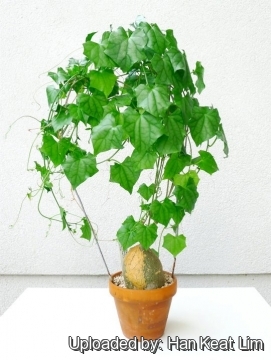 Gerrardanthus megarhiza (Gerrardanthus macrorhizus) Photo by: Han Keat Lim
Gerrardanthus megarhiza (Gerrardanthus macrorhizus) Photo by: Han Keat Lim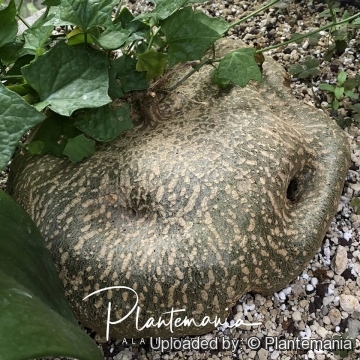 Gerrardanthus megarhiza (Gerrardanthus macrorhizus) Photo by: © Plantemania
Gerrardanthus megarhiza (Gerrardanthus macrorhizus) Photo by: © Plantemania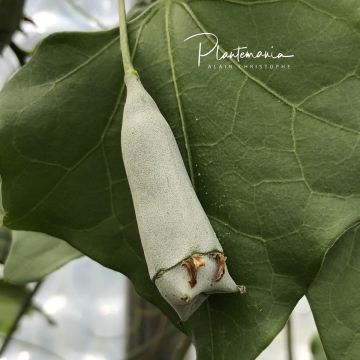 Gerrardanthus macrorhizus - Immature fruit. (Gerrardanthus macrorhizus) Photo by: © Plantemania
Gerrardanthus macrorhizus - Immature fruit. (Gerrardanthus macrorhizus) Photo by: © Plantemania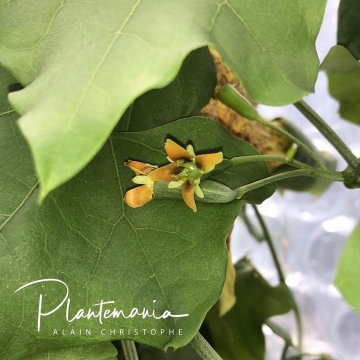 Gerrardanthus macrorhizus - Flowers. (Gerrardanthus macrorhizus) Photo by: © Plantemania
Gerrardanthus macrorhizus - Flowers. (Gerrardanthus macrorhizus) Photo by: © Plantemania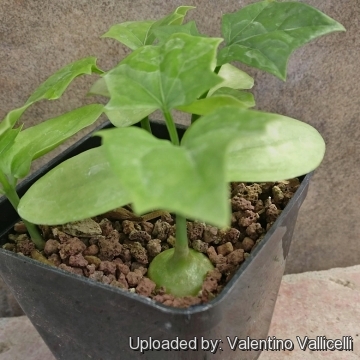 Gerrardanthus macrorhizus - Seedlings 3 Months old. (Gerrardanthus macrorhizus) Photo by: Valentino Vallicelli
Gerrardanthus macrorhizus - Seedlings 3 Months old. (Gerrardanthus macrorhizus) Photo by: Valentino VallicelliSend a photo of this plant.The gallery now contains thousands of pictures, however it is possible to do even more. We are, of course, seeking photos of species not yet shown in the gallery but not only that, we are also looking for better pictures than those already present.
Read More... Cultivation and Propagation: The Bigfoot, Gerrardanthus macrorrhizus, grows well, though slowly, but it possible to increase the speed of growth to some extent by providing that they get abundant water and fertilizer in summer, and a pot large enough. Young plants do great in a hanging basket.
Soil: It like pots with generous drain holes, need a very porous, slightly acidic potting medium (add pumice, vulcanite, and perlite).
Moisture requirements: It should be watered regularly in Summer during the active growing season, but it’s susceptible to rotting if too wet. Kep drier in Winter.
Exposure: It likes a sunny position, but avoid direct blasting sun in summer.
Hardiness: It can be grown outdoors in frost-free climates, need anyway to kept above 0°C and dry in winter.
Maintenance: Repot every two years.
Propagation: Seeds or cuttings.















